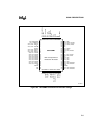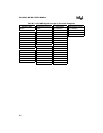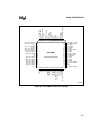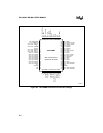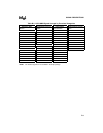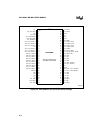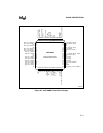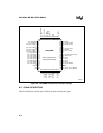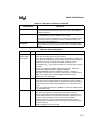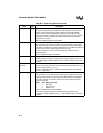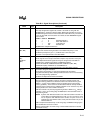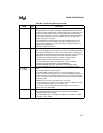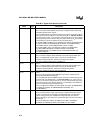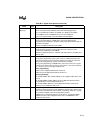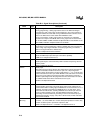
B-13
SIGNAL DESCRIPTIONS
Table B-5. Description of Columns of Table B-6
Column Heading
Description
Name Lists the signals, arranged alphabetically. Many pins have two functions, so
there are more entries in this column than there are pins. Every signal is
listed in this column.
Type Identifies the pin function listed in the
Name
column as an input (I), output
(O), bidirectional (I/O), power (PWR), or ground (GND).
Note that all inputs except RESET# are
sampled inputs
. RESET# is a level-
sensitive input. During powerdown mode, the powerdown circuitry uses
EXTINT as a level-sensitive input.
Description Briefly describes the function of the pin for the specific signal listed in the
Name
column. Also lists any alternate fuctions that are multiplexed with the
signal.
Table B-6. Signal Descriptions
Name Type Description
ACH12:0 (MC)
ACH13:0 (MD)
ACH7:0 (MH)
I Analog Channels
These pins are analog inputs to the A/D converter.
These pins may individually be used as analog inputs (ACH
x
) or digital inputs
(P0.
y
). While it is possible for the pins to function simultaneously as analog and
digital inputs, this is not recommended because reading port 0 while a
conversion is in process can produce unreliable conversion results.
The ANGND and V
REF
pins must be connected for the A/D converter and port 0
to function.
ACH7:0 are multiplexed as follows: ACH0/P0.0, ACH1/P0.1, ACH2/P0.2,
ACH3/P0.3, ACH4/P0.4/PMODE.0, ACH5/P0.5/PMODE.1,
ACH6/P0.6/PMODE.2, ACH7/P0.7/PMODE.3, ACH8/P1.0, ACH9/P1.1,
ACH10/P1.2/T1CLK, ACH11/P1.3/T1DIR, and ACH12/P1.4, and ACH13/P1.5.
ACH13 is not implemented on the 8XC196MC and ACH13:8 are not
implemented on the 8XC196MH.
AD15:0 I/O Address/Data Lines
These pins provide a multiplexed address and data bus. During the address
phase of the bus cycle, address bits 0–15 are presented on the bus and can be
latched using ALE or ADV#. During the data phase, 8- or 16-bit data is trans-
ferred.
AD7:0 are multiplexed with P3.7:0, and PBUS.7:0. AD15:8 are multiplexed with
P4.7:0 and PBUS.15:8.
ADV# O Address Valid
This active-low output signal is asserted only during external memory
accesses. ADV# indicates that valid address information is available on the
system address/data bus. The signal remains low while a valid bus cycle is in
progress and is returned high as soon as the bus cycle completes.
An external latch can use this signal to demultiplex the address from the
address/data bus. A decoder can also use this signal to generate chip selects
for external memory.
ADV# is multiplexed with P5.0 and ALE.



